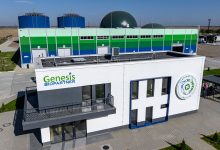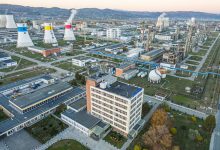Our Environment: Investing in a Healthy Planet
Romania’s energy independence has been a topic debated as much as the recent coronavirus epidemic. But, as a surprise, last year our country was a net electricity importer, whereas imports surged 74%, while exports plunged by 34%, according to data from the National Institute of Statistics (INS).
In 2019, imports totaled 5,110 TWh and exports – 3,592 TWh, resulting in a negative balance of 1,518 TWh. Final electricity consumption of Romania last year was 55.2 TWh, by 1% lower than the level recorded in 2018. Public lighting increased by 10.6%, consumption of population was by 21.9% higher, while consumption in the economy fell by 6.3%. Electricity production stood at 59.3 TWh, by 7.8% lower than in the previous year.
Production in hydropower plants dropped the most, by 12.2%, and that in conventional power plants, by 11.2%. Wind and solar power plants had a higher production, each with 3% more than in the previous year. Own technological consumption in networks and stations was 5.6 TWh, by 6% lower. Internal electricity production was also achieved from production in thermal power plants (23.7 TWh), hydropower plants (15.8 TWh) and nuclear power plants (11.2 TWh), plus significantly lower production of wind power plants (6.7 TWh) and solar energy produced in photovoltaic power plants (1.7 TWh). At this moment, Romania has exceeded the threshold of 250 green buildings, two thirds of them being located in Bucharest.
This is, therefore, the mirror of the system at the beginning of 2020, from which strategies and measures in the field will start.
Inter-ministerial meeting on the implementation of the European Green Deal in Romania
An interministerial meeting took place at the headquarters of the Ministry of Environment, Water and Forests, on how to implement the European Green Deal in Romania, with representation at the level of secretaries of state and technical experts. The purpose of the meeting was to identify an operative way of working through which each authority involved contributes to establishing the national position on certain areas of the European Green Deal, but also assumes different responsibilities.
“The European Green Deal includes a number of legislative and non-legislative initiatives targeting mainly the following fields: environment, climate change, energy, industry, transport, agriculture, digitization and the financial sector. Given the situation at European level, I believe in the following period there will be much faster transformations than the ones assumed so far by the Member States,” said Iulian Octavian Stana, Secretary of State within the Ministry of Environment, Water and Forests.
The Green Diplomacy concept emerges
The pact of the European Commission (Green Deal) is aimed to ensure the sustainable development of the economy by setting measures in order to obtain climate neutrality at EU level by 2050. In this regard, the European Commission will present in March the ‘Climate Law’, a legislative act that will regulate the way forward and the responsibilities of the Member States. In this regard, policies from the relevant fields will be reviewed: energy, industry, biodiversity, transport, circular economy, zero pollution, food (‘From Farm to Fork’), green financing and investments, fair and balanced transition for disadvantaged areas (carboniferous regions in Europe), green research and innovation, education and training, health, including Green Diplomacy in an extremely tight calendar. Also, this process is aimed at preserving and restoring ecosystems and biodiversity, including forest ecosystems.
At the event, details were also presented regarding the Just Transition Mechanism, submitting for debate the proposal for a Regulation on the Just Transition Fund, currently under negotiation at the European Commission level. Following the discussions, it was decided that the relevant authorities would communicate a preliminary assessment of the impact that the implementation of the European Green Deal will have on the field(s) within their competence. Other measures are aimed at appointing responsible persons (Secretary of State and a technical expert) at the level of each ministry involved and transmitting the views of the ministries regarding the negotiation for the Just Transition Fund, carried out by the Ministry of European Funds with the representatives of the European Commission.
Lukoil increases the share capital of the company with wind operations
Russian energy giant Lukoil, through a subsidiary registered in the Netherlands, is in the process of increasing by over EUR 23 million (RON 110 million) the share capital of the Romanian company with operations in the wind energy industry held and operating a profile park with an installed power of 84 MW in Tulcea County. Thus, at the end of last year it was decided that Lukoil International Upstream Holding BV would increase by EUR 23.04mln the capital of Land Power SA, controlled almost entirely, the developer and operator of the wind park Dorobanțu-Topolog, in Tulcea. The park was put into operation in 2014, and its first full year of activity was 2015. The company Land Power SA was set up in 2006 and was initially part of an international joint venture with activities in the renewable energy industry, consisting of Lukoil and Italy’s ERG Renew. The Russian and Italian shareholders subsequently entered a separation process, completed in 2015. The investment in Dorobantu-Topolog wind park, from Tulcea, with an installed power of 84 MW, benefited from financing through loans from EBRD (EUR 38mln) and Unicredit (EUR 19mln).
But, as of 2013, the authorities in Bucharest has started to significantly cut subsidies granted to renewable energy producers in the form of green certificates added in the electricity bills of all consumers of electricity in Romania, to keep under control the final price paid by customers. Also, the accreditation of new renewable energy production capacities for access to the support scheme based on green certificates has been capped. The reduction of subsidies, the most generous in Europe at the beginning of the support scheme for renewable energy, continued in the following years and even resulted in the state being sued at the Washington-based International Centre for Settlement of Investment Disputes of the World Bank (ICSID). The generosity of subsidies has reduced for a while energy prices on wholesale markets, but increased them for end-consumers. The situation changed in 2017 and especially in 2019, following the amendment of the legislation on green certificates, which solved to a great extent the problem of surplus of such instruments on the market. Moreover, the government will raise the target of increasing the share of energy from renewable sources in Romania’s electricity consumption, after being recommended by the European Commission to be ‘more ambitious’ in this regard, and to this end has commissioned a study “for the assessment of the technical-economic potential of renewable resources in Romania, in order to update and fulfill the targets of energy from renewable sources in 2030, under conditions of technical-economic efficiency.” This would create the prerequisites for taking legislative measures in favor of green energy production, which could stimulate investments in this sector. Also, a new support scheme for low-carbon energy producers is under preparation, given that the current subsidies based on green certificates for renewable energy would be granted by 2032. All this has already started to show results, with a massive local transaction in the field recorded last year, through which Sweden’s IKEA took over the Romanian wind farms from Denmark’s Vestas.
Romania wants about 30% energy from renewable sources
Romania aims to reach a target of 30.7% for energy from renewable sources, in total energy consumption, increasing from 27.9%, according to the new draft of the National Integrated Energy and Climate Plan 2021-2030, launched in public debate by the Ministry of Economy, Energy and Business Environment. This while the EU aims to reduce domestic greenhouse gas emissions by at least 40% by 2030, compared to 1990; a renewable energy consumption of 32% in 2030; improving energy efficiency by 32.5% in 2030; interconnection of the electricity market at a level of 15% by 2030.
Consequently, in order to guarantee the achievement of these targets, each Member State was obliged to submit to the European Commission a draft Integrated National Energy and Climate Plan (NECP) for the period 2021-2030, by December 31, 2018. Draft NECPs set national targets and contributions to the achievement of EU climate change objectives. Romania submitted its own draft NECP on that date. But the European Commission has evaluated the draft integrated national energy and climate plans. The analysis included the level of ambition of the objectives, targets and contributions aimed at collectively meeting the EU objectives. In particular, the Union’s 2030 objectives in the field of renewable energy and energy efficiency, as well as the level of interconnectivity of the electricity networks to which the Member States are aiming, have been evaluated. Following the analysis of the integrated plans submitted by all the Member States, it turned out that there is a gap between the EU objectives and the contributions of the Member States in the field of renewable energy and energy efficiency: there is a difference between the 32% RES target assumed at EU level and the result according to these plans, which is between 30.4% and 31.9%. Regarding the share of renewable energy, the European Commission has recommended Romania to increase the level of ambition for 2030, to a share of renewable energy of at least 34%. As a result, the level of ambition regarding the share of energy from renewable sources has been revised compared to the updated version of NECP, from an initially proposed rate of 27.9%, to a rate of 30.7%.
The new target was calculated mainly based on Commission’s recommendation to align the national macroeconomic forecasts with those of the ‘Ageing Report: Economic and Budgetary Projections for the 28 EU Member States (2016-2070)’, but also on the technical-economic potential existing in Romania, in terms of investments in electricity generation capacities from RES, correlated with the decommissioning of coal-fired capacities. Thus, in order to reach the level of ambition regarding the share of energy from renewable sources of 30.7% in 2030, Romania will develop additional RES capacities of approximately 6.9 GW compared to 2015. In order to achieve this target, it is necessary to ensure an adequate financing from the EU in order to ensure a proper adequacy of power grids, but also the flexibility of producing RES-E by installing back-up capacities based on natural gas, storage capacities and the use of smart techniques for power grid management.
“Romania has chosen to adopt a prudent approach regarding the level of ambition, taking into account the national particularities and the need for investments in RES, both for the replacement of the capacities that reach the maximum life time and for the new ones, in order to reach the targets assumed under the NECP, considering that Regulation (EU) 2018/1999 stipulates that in future revisions of the NECP the adjustment of quotas can be made only upwards. In outlining this approach, it should also be mentioned that the process of implementing the recommendations was also faced with a lack of the data needed to draw up a detailed plan regarding the measures, actions, financial resources envisaged by the Romanian authorities for meeting the RES targets in period 2021-2030 especially in the heating-cooling RES area and transport,” the authors of the plan stated.
A new analysis/adjustment of the 2030 target can be made with NECP revision, when the effects of implementing Directive 2018/410 and the programs to support the Green Deal can be much better estimated. “In conclusion, in order to achieve the proposed RES objectives, Romania will develop a series of policies and measures aimed at both reducing energy consumption, but also encouraging the use of RES sources in the relevant sectors – Heating & Cooling, Electricity and Transport, maximizing the synergies between the various actions envisaged. We reiterate that the value of 30.7% represents the minimum limit of the share of energy from renewable resources,” it is also shown in the mentioned document.
The European Commission mentioned, on the other hand, that Romania would have to propose a further reduction of primary and final energy consumption by 2030, so that the Union’s energy efficiency objective be achieved. Therefore, Romania is targeting a primary energy consumption of 32.3 Mtoe, respectively a final energy consumption of 25.7 Mtoe, thus achieving energy savings of 45.1%, relative to the primary consumption for 2030, respectively 40.4% for final energy consumption, compared to the PRIMES 2007 baseline scenario. Moreover, in order to comply with the obligations referred to in Article 7 of Directive 2018/2002 amending Directive 2012/27/EU on energy efficiency, Romania must reach a total value of new energy savings equivalent to 10.12 Mtoe during 2021-2030.
“Following a detailed analysis, Romania has decided to prepare and implement alternative measures and policies encouraging energy savings. Moreover, a Draft Long-Term Renovation Strategy has been presented for public consultation, which will be adopted by March 2020 (the current scenario of renovation provides for significant energy efficiency and CO2 savings, as well as new incentives for the production of RES-E – most in the form of photovoltaic panels for the existing buildings),” according to the document.
Stable energy consumption in the 27 EU Member States
Energy consumption in the 27 EU Member States remained stable in 2018, with primary energy consumption reaching 1.376 billion tons of oil equivalent (toe), 0.71% lower than in the previous year, while final energy consumption reached 990 Mtoe, 0.02% more than 2017, according to data published by the European Statistical Office (Eurostat). The European Union has committed to decrease energy consumption by 20% by 2020, when the primary energy consumption should amount to no more than 1,312 Mtoe and final energy consumption to no more than 959 Mtoe. In 2018, primary energy consumption in the EU was 4.9% above the efficiency target for 2020 and 22.0% away from the 2030 target. Primary energy consumption in 2018, compared with 2017, increased in 12 of the 27 Member States, remained stable in four and decreased in 11 Member States. Compared to 2017, the highest increase was recorded in Estonia (+9%), followed by Latvia (+5%) and Luxembourg (+4%). Among the 11 Member States where primary energy consumption decreased between 2017 and 2018, the largest fall was registered in Belgium (-5%), followed by Greece and Austria (both -3%), Germany and Slovakia (both -2%). In 2018, final energy consumption in the EU was 3.2% above the efficiency target for 2020 and 17.0% away from the 2030 target. Compared to 2017, final energy consumption increased in 15 of the 27 Member States, remained stable in six and decreased in six other Member states. The highest increases were recorded in Malta (+6%) followed by Ireland (+5%), Latvia and Luxembourg (both +4%) and the largest drop was recorded in Greece (-5%), followed by Austria (-3%) and Germany (-1%). Romania recorded a slight increase in the primary energy consumption (from 32.4 million toe in 2017 to 32.4 million toe in 2018) and in the final energy consumption (from 23.2 million toe in 2017 to 23.2 million toe in 2018).
China, global leader in terms of carbon emissions
Neil Kaye, a climatology specialist, has calculated the amount of carbon emissions people are exposed to today, the calculation starting with the Industrial Revolution. World leader is China with 9,839 million tons of CO2 (27.2% of total emissions), the podium being completed by the United States, with 5,269 million tons of CO2 (14.6%) and India, with 2,467 million tons of CO2 (6.8%). These are followed by Russia (4.7%), Japan (3.9%), Germany (2.2%), Iran (1.9%), Saudi Arabia (1.8%), South Korea (1.7%) and Canada (1.6%).
Poland, deal with General Electric
Poland’s Industrial Development Agency signed a letter of intent with US giant General Electric on investment in the area of renewable energy. The partnership aims to develop Poland’s competence in the field of energy generation from renewable sources, the focus being on the development of offshore wind farms and photovoltaic projects in the country.
One of the major stakes of 2020
Several projects have been started by the most important global decision-makers, and hundreds of billions of euros will be invested to put a break on climate change as much as possible. It has become increasingly obvious that the situation regarding the environment is very serious, nature revolts and tens of millions of people suffer from extreme weather events, present on all continents. That being the case, states and large companies have begun to invest heavily in programs dedicated to environmental protection. It should be noted, from the start, that some of these praiseworthy gestures take place under the pressure of public opinion and are not the result of the moral compass.
Bezos Earth Fund has been launched, and Tesla can no longer cut the forest
The European Commission has announced investments of EUR 101.2 million in the latest projects under the LIFE program for environment and climate policies. The funding will support 10 major environmental and climate projects in nine Member States and will help Europe’s transition to a sustainable economy and climate neutrality. These projects will be carried out in Cyprus, Estonia, France, Greece, Ireland, Latvia, Slovakia, Czech Republic and Spain. Integrated projects improve the quality of life of citizens, helping Member States comply with EU legislation in six areas: nature, water, air, waste, climate change mitigation and climate change adaptation. Investments under the LIFE program are meant to raise over EUR 6.5 billion in additional funds, as Member States can also use other EU funding sources, including agricultural, regional and structural funds, the Horizon 2020 program, as well as national funds and investments of the private sector. The large-scale projects will support the European Green Deal and the EU’s ambition to become by 2050 the world’s first climate-neutral continent.
In this context, Jeff Bezos, founder of Amazon and the richest man in the world, has announced on his Instagram account the launch of the ‘Bezos Earth Fund’ to fight climate change. Bezos said he would personally donate USD 10 billion to the fund “for the start” and that the first grants to researchers, activists and NGOs would be awarded this summer.
In the same climate issue, a German court ordered Tesla not to cut the forest off a plot near Berlin, where the company builds its first battery and car factory in Europe, which is a win for environmental activists. The US electric carmaker announced plans last November 2019 to build a gigafactory in Grünheide in the eastern German state of Brandenburg. The ruling by the administrative court of the states of Berlin and Brandenburg comes after the state environmental office gave a green light to clear 92 hectares of forest for the plant. Tesla currently has two factories, one in the US and one in Shanghai, China.
Romania, leading the concern for environmental issues
The population of the world has become very sensitive to this subject. World Economic Forum, one of the most powerful non-governmental organizations in the world, conducted a survey to identify the views of the global population on social issues such as protecting the environment and the importance of information and global cohesion. The survey shows that 58% of Romanians trust what scientists say about the environment. The results of the survey were mentioned in the context of the 50th edition of the traditional meeting of the World Economic Forum, which took place in Davos, Switzerland, during January 21-24, 2020. According to the study, those surveyed (10,500 people from 30 countries that make up about 76% of the global population) believe that human activities are the cause of global warming, even if in some regions there has been a high skepticism about scientific research on the subject. Romania is among the 30 countries included in the study, respectively one of the three countries in the EEC area, besides Poland and Ukraine, the survey giving a concrete perspective on the Romanians’ opinion on this subject. Romania is the second European country in the ranking with such a high percentage, after Italy, with 61%. Among the countries with the highest degree of confidence are India (86%), Bangladesh (78%) and Pakistan (70%), and at the opposite end, with the lowest percentages in this respect, Russia (23%), Japan (25%) and Ukraine (33%). Also, according to the same survey, over 42% of Romanians consider that protecting the environment should be a priority, even if it slows economic growth, and 50% say they follow the news closely and are aware of the public agenda.
Therefore, climate and environmental issues go hand in hand with investments and concerns regarding renewable energy, and humanity and industry become aware that we have no other planet available. Of course, if we don’t buy tickets to travel (one way only) to other planets…







